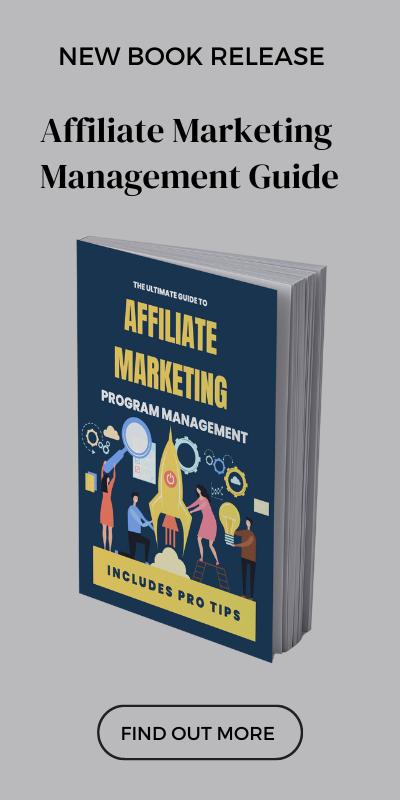It can be overwhelming for you as a small business to decide which digital marketing avenues to pursue. With so much choice and cost, we aren’t sure which way to turn.
That is because, in reality, the best solution is typically a mixed portfolio of different strategies and channels.
Some channels you might be familiar with, such as social or email. While others like affiliates or paid ads might seem like a minefield.
Yes, both can end up being costly if not managed correctly. But, I strongly believe that affiliates can offer a greater reach with less cost for the majority of small businesses.
Instead of jumping headfirst into affiliate strategies and tactics, let’s cover the basics first.
Table of Contents
What is Affiliate Marketing?
When someone asks me what affiliate marketing is, I often refer to this quote from Pat Flynn. Himself a very successful affiliate marketer.
Affiliate marketing is the process of earning a commission by promoting other people’s (or company’s) products. You find a product you like, promote it to others and earn a piece of the profit for each sale that you make.
Pat Flynn, Smart Passive Income Tweet
As the brand, you reach out to websites and offer them the chance to promote your product or service. In return, they can earn a commission on any sales that come through their site.
To track any orders back to the specific affiliate, you need some kind of tracking. Normally, a brand will enter into a contract with an affiliate network for this. Although, there are ways to handle it yourself if you have the resources.
An affiliate network can help facilitate the partnership as they already have a pool of publishers wanting to work with brands. They can also add a tracking script to your site to accurately see traffic and orders from individual partners.
Once the website you want to work with has joined your program, they have the option to grab a unique link. Without this link, the network cannot see what traffic they have sent and if that traffic made any orders.
Benefits of Affiliate Marketing
The clear benefit of affiliate marketing is that you only pay out on performance. In return, you get access to a huge potential audience base.
Costs
Unlike paid ads with a search engine that charges you every time someone clicks a link. You only pay an affiliate once they have driven a sale on your site.
That means an affiliate might send a thousand clicks to your site. But, you only pay them if any of that traffic turns into a qualified customer.
The affiliate (earning commission) and the brand (making sales) are both benefitting in a win-win scenario.
Reach
For a small business acquiring customers can be costly. This is why affiliates are such an attractive option for SME’s.
A lot of affiliates have a large audience of engaged users. These have been crafted over time and could be an ideal target for your business.
How much would it cost in PPC or Display to reach 100k or 200k potential customers?
Well, some affiliates might give you the option to pay for a slot in their newsletter or on their site for a few hundred pounds. If it is the right audience, the ROI on that kind of activity could be great.
Is Affiliate Marketing Right For Your Business?
I am a big advocate of affiliate marketing and have successfully managed programs for many years. Despite this, I feel there are some areas that brands need to be aware of before launching a program.
Hidden Costs
Affiliate networks do a great job of selling you the benefits of affiliate marketing and gloss over other important aspects.
One of these is the affiliate fee.
Some affiliate networks offer small businesses a cheap (sometimes even free) entry into affiliate marketing. But, what you won’t be aware of is something called an override.
Override is the fee they charge you for tracking your program. They take a slice of all your commission paid out to affiliates in any given month. This can be as high as 30%.
When you are just starting, this might not seem like much. But, as your program scales, it is worth reviewing and even re-negotiating this to a lower cost.
Super Affiliates
In 2020 alone, Awin the largest affiliate network in the UK onboarded over 800 new SME’s. Adding to their total of over 15,000 advertisers (brands).
Now, that might sound amazing and give a glimpse into the potential of affiliate marketing for your business. You’d be right.
But, put yourself in the shoes of the affiliates. In particular, those who we call the super-affiliates. These super-affiliates drive massive volumes of orders for the brands they work with. They are typically coupon or cashback sites and occupy the number 1 or 2 slot on most programs.
Everyone wants to work with these guys. So how do they prioritise? They will look at key indicators to perceive whether you are likely to earn them a commission. These could be:
- Website Traffic
- Social Following
- Brand Search Volume
- Domain Ranking
For small businesses, this can mean being overlooked in favour of more established brands. As a new advertiser in the affiliate channel, some of these guys might be off-limits, to begin with.
You won’t be able to go live with all the biggest and best affiliates immediately. But, that doesn’t mean there isn’t a wealth of smaller sites that combined could drive large volumes for you.
Niche Affiliates
Now, all major affiliate networks will have a team scouring the internet and inviting publishers to join their network.
But, an affiliate network simply can’t spend a ton of time on every single possible niche.
If you are in a particularly small niche, you might find the current affiliates on any given network limiting.
There are a few easy ways to combat this:
- Do you own recruitment. I always tell brands that they need to factor in their own recruitment and not just rely on the network. You know your target audience better than anyone else.
- Consider synergy affiliates. Think about other sites your audience might like to visit rather than just those that reflect your niche.
- Big affiliates. These guys have a wide audience that covers a ton of niches. Go all-in on trying to persuade them to get you live. It might mean committing to an exposure package to sway them.
- Hire an expert. An affiliate specialist or agency might have already grown brands similar to you. They will know the publishers and the tactics to use so you scale quicker.
I also list a load more ways to recruit affiliates in my post ‘36 ways to recruit new affiliates‘.
How To Launch An Affiliate Program
The key here is research.
Lots of small businesses read about affiliate marketing then jump into bed with the first network that shows up on their Google search.
Take a step back and have a closer look at the market as a whole. Here are my recommendations on where to start your research:
Competitors
Understand what network your competitors are on and how they are incentivising their affiliates.
Look for these key areas:
- Network
- Commission Tiers
- Cashback Rate
- Discounts
- Program Terms
Affiliate Mix
You might only want to work with certain types of websites. Be aware of how different affiliates can play a significant part at various stages of the customer purchase funnel.
For example, bloggers build brand awareness while a coupon affiliate can help to convert customers.
A small business affiliate partner mix might look like the below:
- Google Shopping / PPC
- Coupons
- Cashback
- Loyalty
- Content
Publisher View
Not all publishers are dying to sign up for every single program. They need to be lured in with a great incentive package.
Additional areas that might lead to more affiliates joining could include:
- Approval Times
- Payout Regularity
- Communication / Support
- Creatives / Content
Anything you can do to make an affiliates promotion of your company easier will pay off in the long term.
Affiliate Challenges
The biggest challenge for any digital marketing activity is the resource. Do you have the team to recruit, engage and incentivise your affiliates? If not, you might need additional support.
By outsourcing some or all of your program management, you can focus on the existing channels that are already successful.
But, be mindful of costs. It can take time to onboard partners, get merchant pages live and start seeing some traction. External support will speed up these areas but instant sales is not a given with affiliate marketing.
If you are looking for more resources to help automate or streamline certain areas of affiliate management. My ‘Resources‘ page covers a lot of the tools I use to manage my programs.
Conclusion
When managed correctly, the affiliate channel opens up a whole new world of potential customers for your company.
Just be mindful that you get out what you put in. Building relationships with new affiliates can take time for a small business. Be prepared to see the first results over longer periods.
Remember, your affiliate program can be as big or as small as you like. To make it manageable, you might only want a handful (at most 10) partners onboard. This way, you can maintain a personal relationship without too much effort.
With your research and channel targets set out before you go live. You should have a clearer view of what affiliate success looks like to your brand.
Best of luck and feel free to drop me an email or comment below if there are any questions you want advice on.




